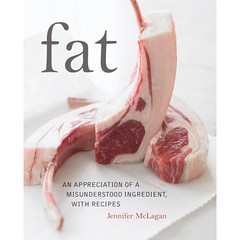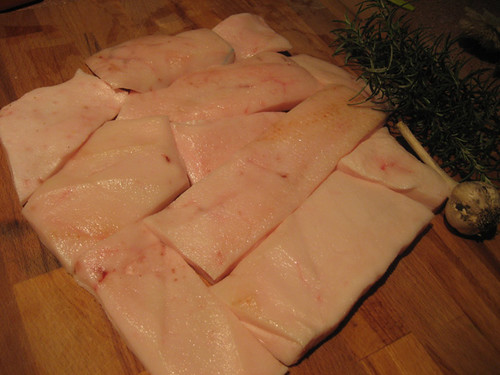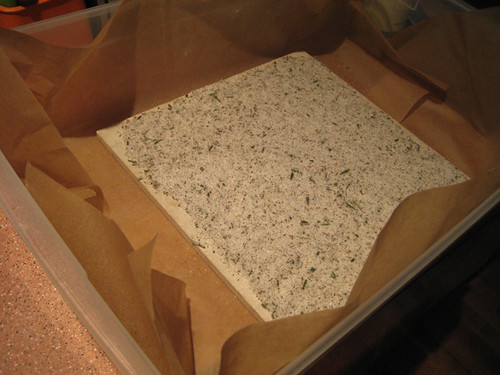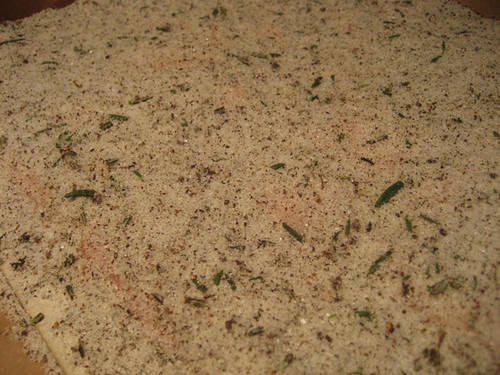I made lardo, seasoned cured pig fat once. (You can see how here.) It was okay. I still have some vacu-packed in my freezer. It really only works as a novelty for parties; you don’t get very far with a spouse saying “Some pigfat for your bread, darling?”
Taken in very small moderation, sliced super-thin and placed on a piece of just-toasted bread that it melts into, it’s a wonderfully decadent thing. Still, my one adventure in lardomaking might have been my only, except that during the production of my current Sky Full of Bacon podcast, starring Rob Vital Information Gardner’s pig head, Rob also gave me the back fat from his hog. It sat in my freezer for a month with no particular end use in mind.
That changed with a conjunction of recent events. One was tasting the house-cured lardo at Vie last Friday. Although Mike Sula and I both found it a little too sweet for our tastes, overall the complexity and lushness of the thinly sliced fat inspired me to want to give lardomaking another shot.
The other was acquiring Jennifer McLagan’s new cookbook Fat. Having admired her book Bones, I even more admired the unabashed attitude behind a book that boldly proclaims:

On pp. 95-6, she gives a much more detailed explanation of where lardo originates than I’d read before:
The method for making lardo has changed little over time. It begins with back fat, usually with the skin still attached, which is cut into thick rectangular slabs. These pieces of fat are rubbed with a spiced sea salt mixture containing black pepper, fresh rosemary and garlic. Each producer adds his own special blend of spices, which can include cloves, cinnamon, coriander, nutmeg, juniper, bay leaves, sage, oregano, thyme and star anise. Once seasoned, the fat is packed into rectangular marble vats called concas. These concas are placed in cellars where the fat ages for six months to two years. During this time the salt draws the moisture from the fat, forming a brine that preserves it, while the combination of spices and herbs adds flavor…
The best-known lardo is lardo di Colonnata, made in Colonnata, a tiny Tuscan town perched in the hulls above the marble quarries of Carrara… The quarries still provide the marble for the local concas, and some producers claim that it is the porous quality of this marble that is the key to the finesse of lardo di Colonnata…
Now, I had my doubts about some of this— for instance, that enough liquid will ever come out of the fat to produce this brine. Nevertheless, now I had a certain model to follow. So I trimmed out the fat, unfortunately it had been cut rather randomly already, but I produced a reasonable assortment of pieces which would fill a square foot:

I went to Home Depot and found two large marble tiles, and to the Container Store to find a box of the right size. Since the box wasn’t food grade, I lined it with parchment paper. If it gets to the point where enough liquid is expressed, I can figure something else out, but for now that seemed fine. I made my spice blend: a lot of sea salt, some black pepper, toasted coriander and juniper, plus ground garlic and rosemary shredded in the food processor. I placed the first marble tile in the box, covered it with a layer of the spices, arranged the pieces tightly together, and packed more spice over them and in all the little crevices:


Finally, I lay the other marble tile on top, and then weighted it down further with some old leftover tiles, which won’t touch food.

Then into the bottom of the beer fridge for the next six months— or more. Check back in April to find out how it turned out!
UPDATE 11/22/08: I started to get nervous about not having any pink salt in my lardo salt mix to ward off the nastiest bugs like Clostridium botulinum. So since I had to move the lardo out of the fridge and into a nearly-as-cold cellar to make room for a thawing T-day turkey, I took the opportunity to scrape a lot of the salt back into a bowl, mix it with an appropriate amount of curing salt, and repack the lardo. A little of the salt around the edges had become crusty, suggesting that a little bit of moisture has been expressed over time, but as expected it’s nowhere near what the bacon does in just a few days. Does that mean it will absorb the pink salt, if there’s no liquid to facilitate osmosis? We shall see in another 4-1/2 months…
Tags: backfat, Charcuterie, curing, fat, jennifer mclagan, lardo

 Posted in
Posted in 




